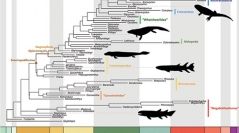

 Comptes Rendus Palevol
18 (7) - Pages 699-709
Comptes Rendus Palevol
18 (7) - Pages 699-709The fossil record provides direct empirical data for understanding macroevolutionary patterns and processes. Inherent biases in the fossil record are well known to confound analyses of this data. Sampling bias proxies have been used as covariates in regression models to test for such biases. Proxies, such as formation count, are associated with paleobiodiversity, but are insufficient for explaining species dispersal owing to a lack of geographic context. Here, we develop a sampling bias proxy that incorporates geographic information and test it with a case study on early tetrapodomorph biogeography. We use recently-developed Bayesian phylogeographic models and a new supertree of early tetrapodomorphs to estimate dispersal rates and ancestral habitat locations. We find strong evidence that geographic sampling bias explains supposed radiations in dispersal rate (potential adaptive radiations). Our study highlights the necessity of accounting for geographic sampling bias in macroevolutionary and phylogenetic analyses and provides an approach to test for its effect.
Sampling bias, fossil record, biogeography, phylogenetics, macroevolution, Tetrapodomorph water–land transition